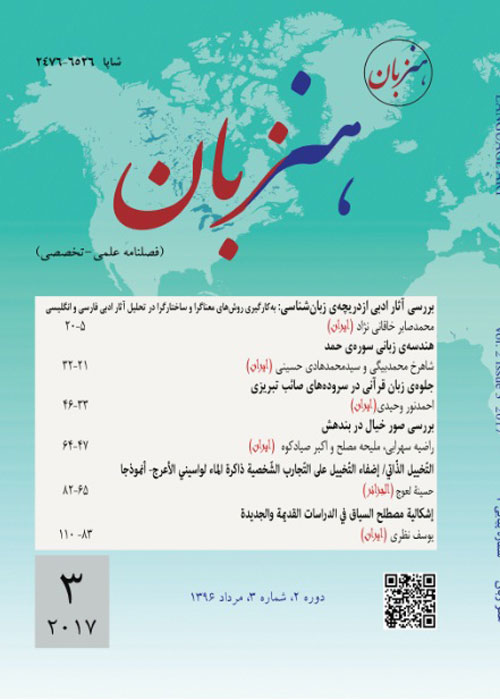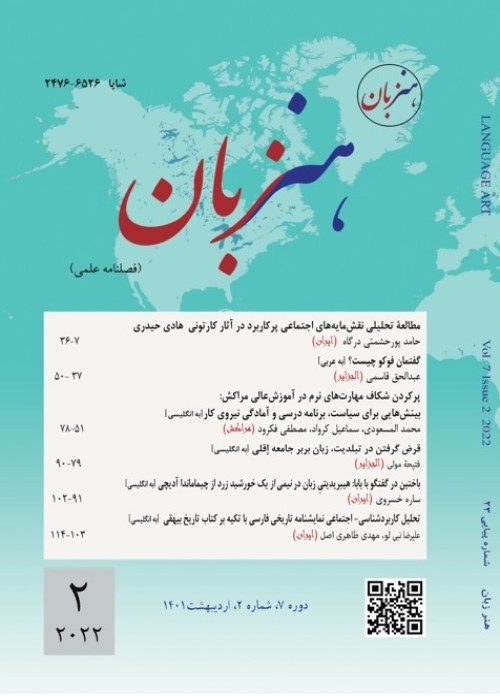فهرست مطالب

نشریه هنر زبان
سال دوم شماره 3 (امرداد 1396)
- تاریخ انتشار: 1396/03/25
- تعداد عناوین: 6
-
صفحات 21-32
-
صفحات 33-46
-
صفحات 47-64
-
صفحات 83-110
-
Pages 5-20During previous decades, choosing the best method for literary criticism so that it would not taint the meaning of works has been attracted the attention of critics all around the world. Applying linguistic-based methods, as contemporary literary criticism methods, help critics to inform readers of literary and lingual senses while being committed to the text. This article has attempted to study and evaluate the ways of applying semantic and structural methods in presenting right literary analysis. Since the application of these methods is not language specific literally nor lingual, some practical examples of applying these methods are presented for studying and criticizing samples of English and Persian literatures.Keywords: Semantic Method of Literary Analysis, Structural Method of Literary Analysis, Literary Senses, Contemporary Literary Criticism
-
Pages 21-32Discussion on the linguistic structure of Surat Al-Hamd rather than being the extensive interpretation issues which are highlighted in the history of religious culture, presents a methodological inquiry with new approaches to the field of Language and Literature. The origin of this method is that of which that selects brevity instead of detail, and instead of subjective and abstract structures, discloses a sensual and objective geometry; i.e., the basis of this article has been derived from a plan for three areas of gratitude, praise and prayer, which is definitely learnable and spectacular in the linguistic structure of Surat Al-Hamd. Certainly, by clarifying the linguistic structure of Surat Al-Hamd, the reasons for the supremacy and conspicuousness of this Surat, and its base in the religious discourse and its incomparable role in devotions and prayers become more apparent. The first manifestation of this linguistic geometry is in the verse of Tasmiyat or Bismillah al-Rahman al-Rahim, in which God's gratitude with praise are intertwined to direct the speech and behavior of believers. Six parts of this essay are all about three sides of semantic and linguistic context of Surat Al-Hamd, which are arranged one by one in the framework of resources of the language of mysticism and the mysticism of the language, and it places the literary researchers as its audience.Keywords: Surat Al–Hamd, Linguistic Geometry, Gratitude, Praise, Prayer
-
Pages 33-46During the history of Persian Literature and Poetry, few poets have not used the endless ocean of religious and Quranic knowledge and concepts in their poems. Because most of the poets were familiar with Quran, Tradition, and the Household, they have enjoyed these concepts in their poems in different ways. Saib Tabrizi was one of these poets who were under the influence of Quran's language in his poems, so he used ethical and Quranic concepts in various manners within the contents of his poems. These concepts include Monotheism, Theology, the Heavens, Resurrection, the Stories of Prophets, Ethics, etc. and sometimes, he used allusion and sometimes he brought a verse or a part of a verse within the content of his poems. The aim of this article is to study how Quran has influenced Saib. The method of the research is descriptive analytical and it is library-based.Keywords: Saib's Divan, Quran's Language, Quranic Concepts, Allusion, Influence
-
Pages 47-64This research aims at the study of figures of speech in Bundahishn. The research paradigm is of the qualitative type, and it is conducted using the content analysis method. The first hand source on which the research has been done is that of translated by Mehrdad Bahar to Contemporary Persian. The results of this research indicate that among the aforementioned figures of speech, simile has the highest frequency. And among different kinds of simile, sensuous simile has the highest frequency. After that comes sensuous-reasonable similes as more frequent which is used for making concepts more abstract.
It seems that simile is one of the most efficient and expressive devices which is used mostly for making educational, philosophical, and abstract concepts pertinent to Creation and other subjects more receivable and concrete. In between, there are some issues which are sensuous, but normally, they are too hard to be understood; however, simile has made them more illuminated. In this work, only one metaphor was found while there is no figures of speech such as metonymy and trope. Maybe, because metaphor, metonymy, and trope make an educational work more difficult and complicated rather than being effective and illuminating. It seems that in this work, the most useful and deliberate style for teaching educational concepts has been used.Keywords: Bundahishn, Figures of Speech, Simile, Metaphor, Metonymy -
Pages 65-82The autobiographical novel differs from the real autobiography since the latter relies on personal and real facts of the writing ego, and the writer is not allowed to say or talk of something that is not related to him. The writer includes his personal experience in the writing according to the conditions set by Philippe Lejeune. Whereas the autobiographical novel belongs to the novelistic genre in which the writer has recourse in the first place to the element of imagination in his artistic work, taking advantage of the factors and techniques which make his novel a higher artistic work since it provides aesthetics. The proof is that the autobiographical novel is given the term Self-imagination at present because of its propensity for imagination in describing real facts that the writer reports reality to others with his creative composition.Keywords: Self-imagination, Autobiographical Novel, Autobiography, Game of Pronouns, Imaginary Description, Monologue, Dialogue Techniques, Aesthetics
-
Pages 83-110A challenge of modern studies is terms. On one hand, terms have different implications in different sciences and on the other hand, authors usually use a specific term for different implications. Thus, the variety of terms is due to various issues. Sometimes, despite the existence of common terms, authors and translators establiesh new terms, and sometimes, while neglecting the semantic delicacy of each term, they are used in a quite different sense. One of these terms is Al-siaq. This term has an entirely different implications in the old Arabic linguistic studies in comparison with its implications in modern studies. In the old studies, this term has just been used for linguistic context by different authors; however, there were some other common terms such as Al-hal, Al-hal al-moshahedeh, Maqam, and Siaq al-qesse among old linguists for non-linguistic context. But, in modern studies, the term siaq has been applied for linguistic context, non-linguistic context, and context in general, whether linguistic or non-linguistic, as numerous terms have been established for each of these categories. This issue has made the understanding of the ultimate meaning much complicated.Keywords: Terminology, Al-siaq, Linguistic Context, Non-linguistic Context


